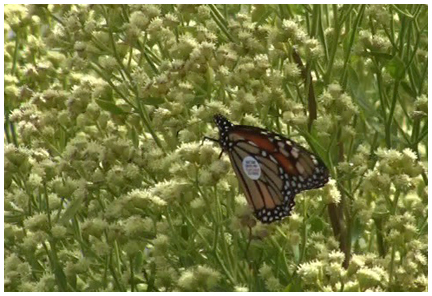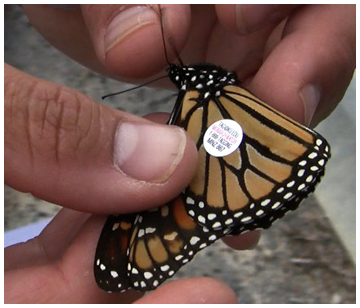
Monarch beauties pass through the Florida Panhandle
Joe Wyatt, naturalist at Hammock Bay in Freeport has been tagging Monarch butterflies for three years as part of a migration study with the University of Kansas.
So far in this year’s study, Joe has tagged 68, finding the majority of the fluttering beauties feasting on Saltwater False-Willow, Narrowleaf Baccharis (Baccharis angustifolia) along the north shoreline of Choctawhatchee Bay in Choctaw Beach.
Unlike most other insects in temperate climates, monarch butterflies cannot survive a long cold winter. Instead, they spend the winter in roosting spots. Monarchs east of the Rocky Mountains fly farther south to the forests high in the mountains of Mexico. The monarch’s migration is driven by seasonal changes. Day length and temperature changes influence the movement of the monarch.
No other butterflies migrate like the monarchs of North America. They travel much farther than all other tropical butterflies, up to three thousand miles. They are the only butterflies to make such a long, two-way migration every year. Amazingly, they fly in masses to the same winter roosts, often to the exact same trees of their ancestors, making the round-trip only once. Their children’s grandchildren return south the following fall.

When the late summer and early fall monarchs emerge from their pupae, or chrysalides, they are biologically and behaviorally different from those emerging in the summer. The shorter days and cooler air of late summer trigger changes. In Minnesota this occurs around the end of August. Even though these butterflies look like summer adults, they won’t mate or lay eggs until the following spring. Instead, their small bodies prepare for a strenuous flight. Otherwise solitary animals, they often cluster at night while moving southward. If they linger too long, they won’t be able to make the journey; because they are cold-blooded, they are unable to fly in cold weather.
As they migrate southwards, Monarchs stop to nectar, and actually gain weight during their journey. Some researchers think that Monarchs conserve their “fuel” in flight by gliding on air currents as they travel south. This is an area of great interest for researchers; there are many unanswered questions about how these small organisms are able to travel so far.
Another unsolved mystery is how monarchs find the over-wintering sites each year. Somehow they know their way, even though the butterflies returning to Mexico each fall are the great-great-grandchildren of the butterflies that left the previous spring. No one knows exactly how their homing system works; it is another of the many unanswered questions in the butterfly world.
Their flight pattern is shaped like a cone, as they come together and pass over the state of Texas on their way south. In massive butterfly clouds, they sweep up into the mountain ranges of central Mexico. In 1975 the scientific community finally tracked down the wintering sites of the Monarch in Mexico. Until then, the Monarch butterflies’ winter hideouts had been a secret known only to local villagers and landowners.
The University of Kansas explains why they tag monarchs:
Many questions remain unanswered about the fall migration of the monarch population east of the Rocky Mountains. How do the monarchs move across the continent, i.e. do they move in specific directions or take certain pathways? How is the migration influenced by the weather and are there differences in the migration from year to year? We need data to answer these questions and we need your help! Only through the cooperative efforts of volunteer taggers will we be able to obtain sufficient recoveries and observations of the migration to answer these questions. Because monarchs have a certain “charisma” and a fascinating biology and because its fun to have an excuse to collect butterflies, this project is also a good way to introduce students to science and have them contribute to a scientific study. Through participation in this project we also hope to further interest in the conservation of habitats critical to the survival of the monarch butterfly and its magnificent migrations. Click here to view map
Information courtesy University of Kansas. To learn more about monarch butterflies, or find out how you can participate, go to http://www.monarchwatch.org

Caroling Geary
October 23, 2009Thanks for the closeup video of tagging. I wonder if there are studies comparing a butterfly’s well-being before and after capture, handling, and tagging. Isn’t there a dusty covering on the wings? Wouldn’t the tagger’s skin oils muss up the surface? I guess the experience for the butterfly is like alien abduction would be for a human. I do hope the research gained will help set up preserves for the Monarchs’ habitats. Then the stress will have paid off.